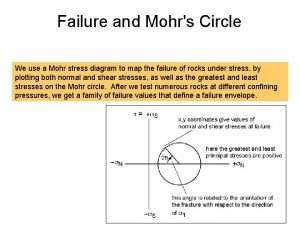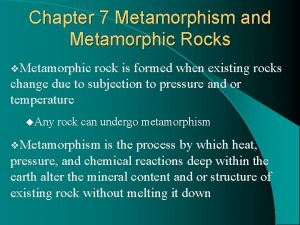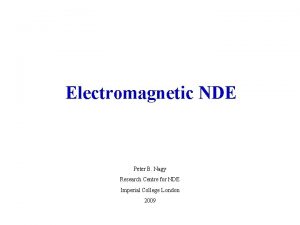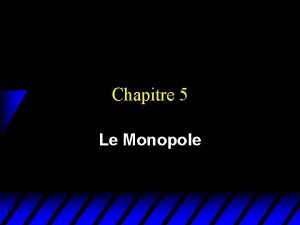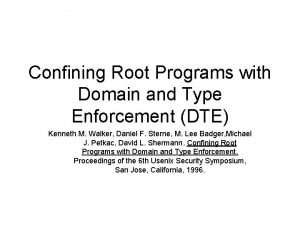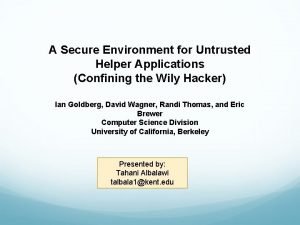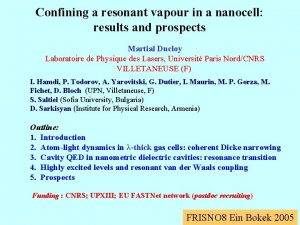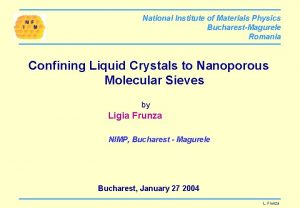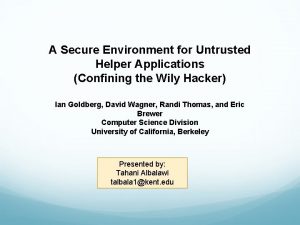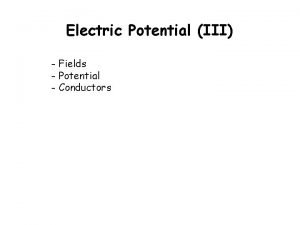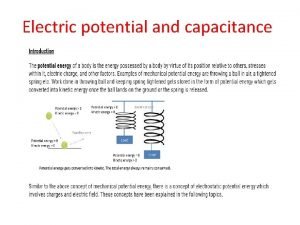The confining potential and a lowenergy effective monopole






![new data m = 337 [Me. V] m = 400 [Me. V] preliminary (abelian) new data m = 337 [Me. V] m = 400 [Me. V] preliminary (abelian)](https://slidetodoc.com/presentation_image_h2/96431149a0df8080be3b666bb1962e7c/image-7.jpg)






![Block spin renormalization trajectory m = 400(4) [Me. V] m = 444(4) [Me. V] Block spin renormalization trajectory m = 400(4) [Me. V] m = 444(4) [Me. V]](https://slidetodoc.com/presentation_image_h2/96431149a0df8080be3b666bb1962e7c/image-14.jpg)

- Slides: 15

The confining potential and a lowenergy effective monopole action under two flavours of dynamical quarks M. Hasegawa, K. Ishiguro, Y. Nakamura, T. Sekido, T. Suzuki University of Kanazawa and DESY (This was done as DESY-ITEP-Kanazawa (DIK) collaboration)

Purpose: Color confinement is explained beautifully by the Abelian dual Meissner effect due to monopole condensation in pure QCD (Ref. Koma et. al. Nucl. Phys. 119, 676(2003) and ref. therein) What happens in full QCD ? 1) To study the role of Abelian monopoles in full QCD and 2) to clarify the effect of dynamical light quarks on monopole dynamics are our purposes. Previously (DIK: Ref. Phys Rev D. 70. 074511 (2004)) we investigated these problems using configurations with m ¼ 550 ~ 1100 [Me. V] and observed some effects of dynamical quarks on monopoles. But the results are not so largely different from those in pure QCD. Here we report the results of our study using new configurations with lighter pion masses (~300[Me. V]).

Simulation details We perform our simulations with two flavours of non-purtubatively improved clover Wilson fermion and Wilson gluonic actions. ・Simulation parameters are listed New configurationes! (New Configurations are generated using Blue. Gene at KEK by Kanazawa group and using Blue. Gene Jülich and Edinburg by QCDSF) We perform abelian (MA) gauge fixing for those configurations

Method After MA gauge-fixing, we extract Abelian link fields and monopoles and evaluate Abelian and monopole quantities. In SU(2) case for simplicity: U : non-Abelian link variable C : off-diagonal part u : diagonal part Abelian field strength : monopole current

Abelian and non-Abelian static potentials preliminary Abelian dominance is seen in the linear part also in full QCD.

Monopole, Abelian and photon static potentials preliminary Monopoles are responsible for the linear potential.
![new data m 337 Me V m 400 Me V preliminary abelian new data m = 337 [Me. V] m = 400 [Me. V] preliminary (abelian)](https://slidetodoc.com/presentation_image_h2/96431149a0df8080be3b666bb1962e7c/image-7.jpg)
new data m = 337 [Me. V] m = 400 [Me. V] preliminary (abelian) / (nonabelian) ¼ 0. 9 (monopole)/ (abelian)/ (nonabelian) Abelian dominance and monopole dominance new data m = 400 [Me. V] m = 337 [Me. V] preliminary (monopole)/ (abelian) ¼ 0. 8 The left figure shows “Abelian dominance” and the right figure shows “monopole dominance”.

Monopole Cluster Monopoles form as cluster since the conservation law exists. Clusters of monopole are divided into two parts small cluster (i) Large cluster infrared (ii) Small cluster ultraviolet The separation becomes clearer when the physical volume is larger. large cluster

Monopole density monopole density is defined as , preliminary Saturation is seen for both cases!

Gribov copies (monopole) This figure shows the dependence of Gribov copies for the monopole string tension. ・ Gribov copy effects are important in MA gauge-fixing.

An effective monopole action ・ An effective monopole action is defined in the following; Effective monopole action : gauge-fixing condition : Fadeev-Popov determinant

An effective monopole action and block spin transformation Effective monopole action can be obtained by Inverse Monte-Carlo method. Block-spin (type 2) transformation of monopoles:

Effective monopole action dependence of the self coupling G 1. New data m = 444(4) [Me. V] m = 400(4) [Me. V] G 1 decreases as is smaller
![Block spin renormalization trajectory m 4004 Me V m 4444 Me V Block spin renormalization trajectory m = 400(4) [Me. V] m = 444(4) [Me. V]](https://slidetodoc.com/presentation_image_h2/96431149a0df8080be3b666bb1962e7c/image-14.jpg)
Block spin renormalization trajectory m = 400(4) [Me. V] m = 444(4) [Me. V] b = na number of block spin : n quenched QCD NEW data! old DIK data Clear dependence on pion masses is seen in the renormalization trajectories!!

Summary and conclusion • Abelian and monopole dominances are observed also for these light quark masses. • Monopoles are responsible for the linear part of the static potential. • The behavior of block spin trajectories is seen to depend on the pion mass clearly. The reason is not known yet, but interesting. • To study the chiral and the continuum limits is important. • It is also interesting to study monopole effects on the finite -temperature phase transition in full QCD with lighter quark masses. • We are planning to study the finite-temperature case.
 Metamorphic grade
Metamorphic grade Mohr diagram geology
Mohr diagram geology Dynamothermal
Dynamothermal Le tableau de stackelberg
Le tableau de stackelberg Oligopole monopole duopole
Oligopole monopole duopole Wave impedance
Wave impedance Maxwell's equations magnetic monopoles
Maxwell's equations magnetic monopoles Graded potential
Graded potential Equipotential lines
Equipotential lines Electric potential energy and potential difference
Electric potential energy and potential difference Water potential in plant cells
Water potential in plant cells Market potential and forecasting
Market potential and forecasting Electric potential and potential difference
Electric potential and potential difference Potential due to charged sphere
Potential due to charged sphere Electric potential and potential energy
Electric potential and potential energy Electrostatic potential
Electrostatic potential

